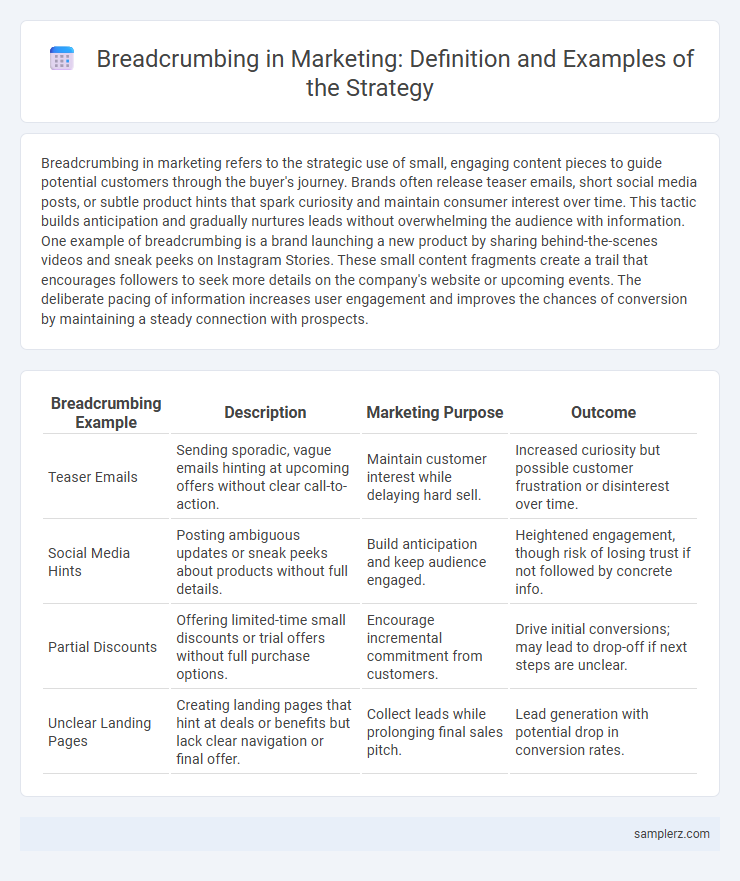Breadcrumbing in marketing refers to the strategic use of small, engaging content pieces to guide potential customers through the buyer's journey. Brands often release teaser emails, short social media posts, or subtle product hints that spark curiosity and maintain consumer interest over time. This tactic builds anticipation and gradually nurtures leads without overwhelming the audience with information. One example of breadcrumbing is a brand launching a new product by sharing behind-the-scenes videos and sneak peeks on Instagram Stories. These small content fragments create a trail that encourages followers to seek more details on the company's website or upcoming events. The deliberate pacing of information increases user engagement and improves the chances of conversion by maintaining a steady connection with prospects.
Table of Comparison
| Breadcrumbing Example | Description | Marketing Purpose | Outcome |
|---|---|---|---|
| Teaser Emails | Sending sporadic, vague emails hinting at upcoming offers without clear call-to-action. | Maintain customer interest while delaying hard sell. | Increased curiosity but possible customer frustration or disinterest over time. |
| Social Media Hints | Posting ambiguous updates or sneak peeks about products without full details. | Build anticipation and keep audience engaged. | Heightened engagement, though risk of losing trust if not followed by concrete info. |
| Partial Discounts | Offering limited-time small discounts or trial offers without full purchase options. | Encourage incremental commitment from customers. | Drive initial conversions; may lead to drop-off if next steps are unclear. |
| Unclear Landing Pages | Creating landing pages that hint at deals or benefits but lack clear navigation or final offer. | Collect leads while prolonging final sales pitch. | Lead generation with potential drop in conversion rates. |
Understanding Breadcrumbing in Marketing
Breadcrumbing in marketing refers to the strategic use of subtle, incremental messages or offers aimed at maintaining consumer interest without immediate conversion. Companies employ breadcrumbing tactics through personalized emails, social media teasers, or limited-time discounts to keep prospects engaged while gradually guiding them toward a purchase decision. Recognizing breadcrumbing allows marketers to optimize customer journeys by balancing engagement and anticipation effectively.
Common Breadcrumbing Tactics Used by Brands
Brands often use breadcrumbing tactics such as sending sporadic promotional emails or partial product information to keep consumers interested without committing fully. Limited-time offers and exclusive sneak peeks tease customers, prompting repeated visits to the website without immediate purchases. Social media engagement with vague or incomplete updates also entices users to stay connected while delaying deeper brand loyalty or conversion.
How Social Media Platforms Employ Breadcrumbing
Social media platforms use breadcrumbing by intermittently posting engaging content that encourages users to return without committing fully, such as teaser videos or limited-time offers. This tactic keeps potential customers intrigued and repeatedly interacting with brand pages, increasing brand visibility and user retention. By strategically dropping subtle cues and updates, platforms effectively nurture curiosity while driving ongoing engagement.
Breadcrumbing in Email Marketing Campaigns
Breadcrumbing in email marketing campaigns involves sending a series of carefully crafted, incremental messages that gradually engage prospects without overwhelming them. These emails typically offer small pieces of valuable content or exclusive offers, designed to maintain interest and guide recipients toward a purchase decision. This strategy improves open rates and click-through rates by fostering curiosity and building anticipation over time.
Examples of Breadcrumbing on E-commerce Websites
E-commerce websites often use breadcrumbing by displaying navigational paths like Home > Electronics > Smartphones to help users easily trace their location within the site. This method enhances user experience by allowing quick backtracking to broader categories, reducing bounce rates and increasing time-on-site metrics. Implementing breadcrumb trails also improves SEO by providing search engines with clear site structure and keyword-rich anchor text.
The Role of Breadcrumbing in Customer Retention
Breadcrumbing in marketing involves sending small, enticing messages or offers that keep potential customers engaged without requiring a full commitment, effectively nurturing leads over time. By strategically delivering personalized content and incremental incentives, brands maintain customer interest and build anticipation, which enhances long-term engagement and loyalty. This subtle approach helps sustain brand awareness and improves customer retention rates by guiding consumers through the sales funnel with minimal pressure.
Subtle Breadcrumbing in Influencer Collaborations
Subtle breadcrumbing in influencer collaborations involves brands providing influencers with exclusive product hints or limited previews to generate curiosity and anticipation among their followers. This tactic encourages engagement and sustained interest without fully revealing the campaign or product, fostering organic buzz and word-of-mouth promotion. By strategically releasing teaser content, marketers can effectively build hype and enhance brand loyalty through influencer-driven storytelling.
Breadcrumbing Strategies in Content Marketing
Breadcrumbing strategies in content marketing involve creating a series of interconnected, micro-content pieces that guide potential customers through the buyer's journey by gradually revealing valuable information. Using strategically placed links, teasers, and calls-to-action within blog posts, videos, and social media updates helps maintain audience engagement and encourages deeper exploration of a brand's offerings. This approach enhances user experience, increases website dwell time, and ultimately boosts conversion rates by nurturing leads with consistent, bite-sized content.
Case Studies: Breadcrumbing Success Stories
Brands like Amazon master breadcrumbing by using personalized email campaigns that gradually reveal exclusive deals, increasing customer engagement and sales conversion rates. Netflix employs breadcrumbing through tailored content recommendations, subtly guiding users to explore more shows and boosting subscription retention. These case studies demonstrate how strategic, incremental messaging fosters deeper consumer relationships and sustained brand loyalty.
Ethical Considerations of Breadcrumbing in Marketing
Breadcrumbing in marketing involves offering minimal engagement or misleading signals to keep customers interested without delivering substantial value, raising significant ethical concerns. This practice can erode trust, damage brand reputation, and potentially lead to consumer backlash or regulatory scrutiny. Ethical marketing demands transparency and genuine value to foster long-term customer loyalty and avoid deceptive tactics associated with breadcrumbing.

example of breadcrumbing in marketing Infographic
 samplerz.com
samplerz.com